From Ierapetra to Malles and Pano Simi SEE ALL AVAILABLE ROUTES
West of the ancient settlement of Gournia lies the Monastery of Panagia Faneromeni (Our Lady Revealed), whilst the Church of Agios Georgios, adorned with murals, is located in Assari, just to the south. We will visit the churches of Agios Georgios, Agioi Apostoloi and Zoodohos Pigi in the picturesque village of Kavoussi, to admire their murals, as well as the nearby Church of Koimisios tis Theotokou (Dormition of Mother Mary). We can also visit the churches of Agia Eirini and Agios Antonios in the tiny hamlets of Avgo and Tholos, respectively.
The Diocese includes the churches of Agios Georgios and Agios Haralampos. The Metropolitan Church of Agios Georgios, the Church of Metamorfoseos Sotiros (Transfiguration of the Redeemer), the Church of Agios Haralampos and the Church of Agios Nikolaos, as well as the Agioi Pantes (All Saints) or Agiasmenos Monastery and Anastaseos Kiriou (Resurrection of the Lord) and Axion Esti Monastery, are all located in the city of Ierapetra.
The churches of Kato Ai-Giorgis, Panagia, Agios Mamas and Panagia Keragrammeni, all adorned with murals, can be found in the village of Kapistri, also known as Agios Georgios.
We will visit the churches of Timios Prodromos, Agios Georgios and Agia Marina in the hamlet of Messeleri and then continue east to visit the mural-adorned catholicon of Panagia Vriomeni Monastery.
The traditional hamlet of Anatoli is home to the churches of Agioi Pantes (which features an interesting collection of icons) and Kato Panagia, as well as Kato Karkasia Monastery, Pano Karkassia Monatery and Panagia Vayionea monasteries.
Continuing onwards to Males, we come across Exakousti Monastery. The hamlet itself is home to the churches of Metamorfosi Sotiros and Agios Haralampos, as well as the mural-adorned churches of Agios Nikolaos, Panagia Mesochoritissa and Agios Georgios at Loutra.
Following the route south through the valley, in the village of Mythi we will visit the Monastery of Panagia at Karydi and in the coastal hamlet of Myrtos we will visit the Church of Agios Antonios.
In Gdochia, a small village with a longstanding tradition in pottery, we will come across the Church of Evangelismos tis Theotokou, and in Epano Simi we will come across the mural-adorned Church of Agios Georgios.
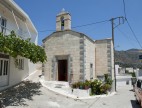
Agios Nikolaos (St. Nicholas) (Malles)
Dating back to the late Byzantine period, this church is built in the architectural style of free cross without dome and has but a few surviving murals.
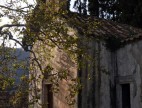
Saint George at Apano Symi
St. George is located at the entrance of the deserted settlement of Apano [Upper] Symi, and a little outside the settlement of Kato [Lower] Symi of Viannos. The architectural plan of the church is the result of the addition of a spacious transept to the original, single-nave church, which is not far in date from […]
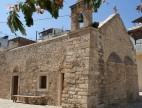
Church of Agios Antonios (St. Anthony) (Mirtos)
Dedicated to Saint Anthony and to the Ascension of Christ, this single-aisled church was likely built in the late 14th century. It was later destroyed and subsequently rebuilt in 1853. Ancient pieces of marble, parts of statues and column bases can be seen in sections of its western wall and in its altar.
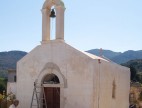
Saint George at Meseleroi
The single-nave church of St. George is located at the centre of the settlement of Meseleroi. Its wall painting decoration dates to around 1300 and is partially preserved. The large representation of the Ascension develops on the east section of the barrel-vault, while on the west, are a few representations from the cycle of the […]
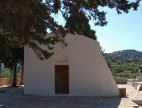
Saint Marina at Meseleroi
The single-nave church of St. Marina, whose south side is formed with a large buttress, is located on the east corner of the settlement of Meseleroi. It is dated according to the wall painting decoration, the work of an anonymous but excellent painter, to the first quarter of the 14th century. Its iconographic programme presents […]
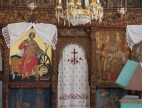
All – Holy Virgin the Mesochoritissa [‘of the Middle Land’] at Malles
The single-nave church of the All-Holy Virgin, in the centre of the settlement, was expanded to the west during a second phase. The two construction phases correspond also to the two layers of wall painting decoration that adorn its interior. The older, in the east and central sections, dates to the early 14th century, a […]
Panagia Keragrammeni (Our Lady Inscribed) (Kapistri)
This small, single-space arch-covered church is dedicated to the Nativity of Mary and is extensively decorated with 15th century murals. Despite not being particularly well preserved, the murals are rather impressive and of excellent quality. The depictions of the Virgin and Child and of Jesus Christ stand out amongst them.
Agios Mamas (Saint Mammes) (Kapistri)
Originally a small arch-covered church, it was later extended with additions to its western side. Its murals of excellent technique have not been preserved well. Also impressive are the full-body depictions of saints and that of Saint George on his mount.
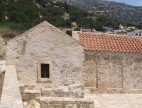
Kato Ai Giorgis (Lower St. George) (Kapistri)
This is a 14th century stone-built Byzantine church with unique murals. Although it was originally built in the classic arch-covered style, a transverse narthex was added at a later date, forming a “T” shape with the main part of the church. Its exceptional surviving murals portray the Birth, the Baptism and the Presentation at the […]
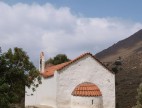
Church of Koimisi tis Theotokou & Agios Ioannis o Theologos (Dormition of Mother Mary & St. John the Divine) (Kavoussi)
This grand two-aisled church was built in 1847 and served as village cathedral until 1962. It was renovated in 2002. Its three-lobed belfry and gilded chancel screen with its 19th century icons are noteworthy. The church is home to a collection of 17th-19th century icons, most noteworthy of which is an early 17th century depiction […]
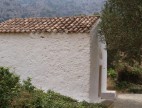
Agia Irini (St. Irene) (Kavoussi)
The single-space, Byzantine church dedicated to Saint Irene dates back to 1410 and is a modest arch-covered church adorned with murals.
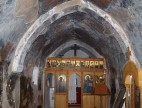
The Church of Agioi Apostoloi at Kavousi
The single-nave church of the Holy Apostles, 100 metres to the south of St. George, also has two layers of wall paintings of the 14th and 15th centuries respectively. From the first layer very few forms can be discerned, such as the full-length figure of the woman donor on the north wall who has the […]
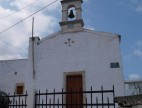
The Church of St. George at Kavousi
The large number of churches within and without the settlement of Kavousi is evidence of its flourishing, mainly during the period of Venetian occupation. St. George, in the centre of the settlement, belongs to the architectural plan of the single-nave church with a transverse, tripartite narthex. It has two layers of wall painting decoration of […]
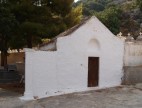
Zoodochos Pigi (Life-giving Font) (Kavoussi)
The Byzantine church of the Life-Giving Font dates back to the 14th century. It is a small arch-covered church, though its murals are largely destroyed. Of particular interest are the depictions of the Akathist Hymn.
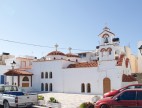
Church of Metamorfosi Sotiros & Agios Haralampos (Transfiguration of the Redeemer & St. Charalampus) (Ierapetra)
Most likely built between 1150 and 1160, this is the city’s oldest church. It was originally a single-space arch-covered church, but a second aisle, dedicated to Saint Charalampus, was added in the early 17th century. The two-dome narthex is a more recent addition. Its unique wood-carved chancel screen features icons by the famed painter Kastrofilakas, […]
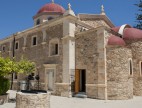
The Church of St. George at Ierapetra
The most important church of the city is the metropolitan church of St. George, who is also the patron saint of Ierapetra due to his wonderworking interventions during the period of Turkish occupation. The church, which is also located in the historical centre of Kato (Lower) Mera, was built in the 19th century in place […]
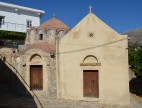
Church of Agios Georgios and Agios Haralampos (St. George & St. Charalampus) (Episkopi)
The church of Saint George and Saint Charalampus is one of the most important religious monuments in the region of Ierapetra. The 11th century Byzantine bathhouse that originally stood on the site was converted into a church, possibly during the 16th century. Byzantine bathhouses and churches shared many architectural elements, and, as a result, abandoned […]
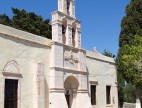
Evangelismos tis Theotokou (Annunciation of the Virgin Mary) (Gdochia)
The miraculous, according to tradition, church dedicated to the Annunciation of the Virgin Mary was erected between 1825 and 1835. It features a unique stone belfry that is considered to be one of the most elaborate on Crete.
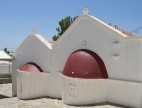
Church of Kato Panagia (Lower Mother Mary) (Anatoli)
An arch-covered Byzantine church dedicated to the Dormition of Mother Mary. Its striking murals are quite well preserved.
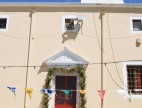
Ecclesiastical Collection of all – Saints at Anatoli
The twin-naved church of All-Saints, which was erected in 1873, is located on the south side of the settlement of Anatoli and in a location with a panoramic view of the plain. A series of three columns divides the two aisles whose roof forms four saucer domes above each one. The collection of ecclesiastical artefacts […]
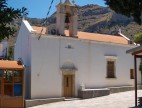
Holy Monastery of Exakousti
The Monastery of Exakousti [‘the Renowned’] is located in the northwest part of the province of Ierapetra between the settlements of Anatoli and Malles. Compared with other monasteries in the vicinity, such as the All-Holy Virgin of Armos at Malles and the All-Holy Virgin the Karydiani [‘of the Walnuts’] at Mythoi, it is a relatively […]
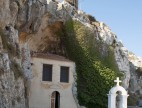
Holy Monastery of Faneromeni at Ierapetra
The monastery, which celebrates on the Dormition of the Theotokos, is located on the north side of Mount Stavros, a steep elevation west of the archaeological area of Gournies. Its foundation date is unknown even though non-extant sources mention it already at the end of the 13th century, connecting it with the revolution of the […]
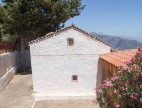
Panagia Karydiou (Mother Mary of Karydi) Monastery
The monastery is built at an altitude of 750 metres, on a spot that affords it a spectacular view. It serves as a glebe of Panagia Faneromeni Monastery, and its catholicon is dedicated to the Life-Giving Font (originally, it was dedicated to the Nativity of Mary). It was renovated in 1839, but none of its […]
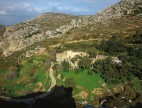
Holy Monastery of the All – Holy Virgin Vryomeni [‘The Abundant’] at Meseleroi
Even though the exact date of the foundation of the monastery is unknown, its function is witnessed already from the 16th century while the catholicon of the early 15th century shows the use of the space from the late Byzantine period. The monastery is built on a rocky outcrop, east of the settlement of Meseleroi, […]
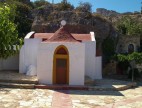
Vayionea Convent
Abandoned at present, Vayionea Convent was founded in the late 14th century by the scholar Nilos Damilas. The only surviving structure is the catholicon, a single-space arch-covered church with a conical dome, the north side of which abuts the rock.
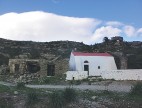
Christ the Saviour of Pano Karkasa
The church of the Saviour Christ, entirely covered in wall paintings, that is located to the southwest of the village of Anatoli at a distance of around five kilometres, was the catholicon of a male monastery. Its location in the immediate vicinity of the Monastery of the Holy Apostles as well as the fact that […]
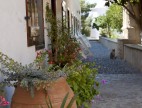
Agioi Pantes (All Saints) Agiasmenou (Sanctified) Convent
Agiasmenou Convent is dedicated to All Saints. In the late 19th century, it served as a retreat for the Bishop of Ierapytni and Siteia. Following restoration, it currently functions as a convent.
Holy Apostles at Kato Karkasa
The church of the Holy Apostles which is located to the south of the settlement of Anatoli was the catholicon of a small, female monastic complex, from which very few ruins survive to the south of the church. The monastery of Karkasia, as it is referred to in the sources of the end of the […]
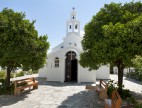
Anastassi (Resurrection) and Axion Esti (It Is Truly Meet) Convent
The Axion Esti Convent, founded in 1984 by the Metropolitan Philotheos II, is located near the city of Ierapetra. The catholicon is a three-aisled church dedicated to the Virgin Mary, the Annunciation and the Resurrection of the Lord. It is replete with murals, featuring work that is characteristic of the Cretan School, and its altar […]


